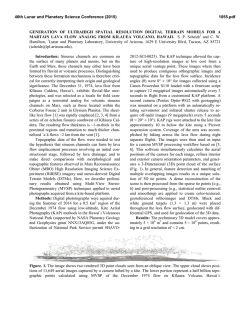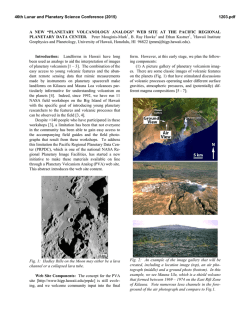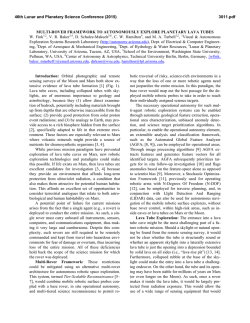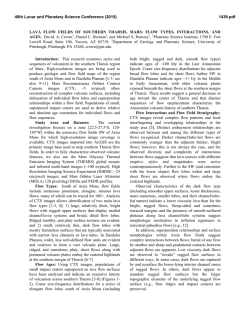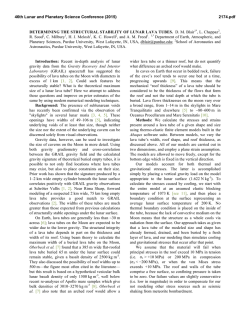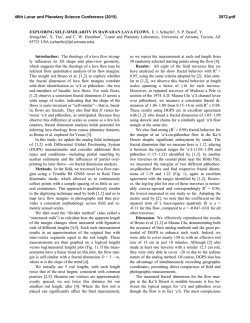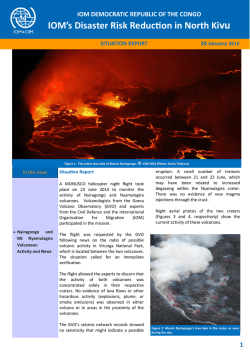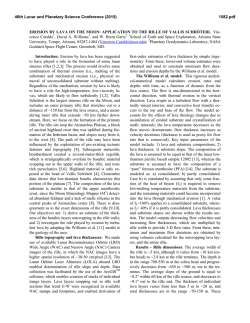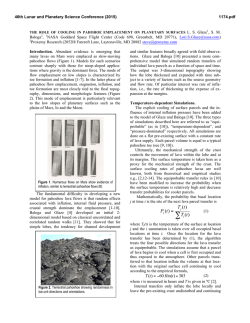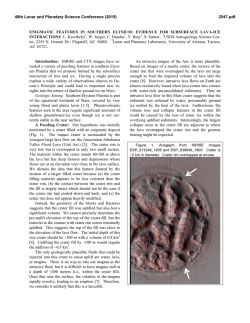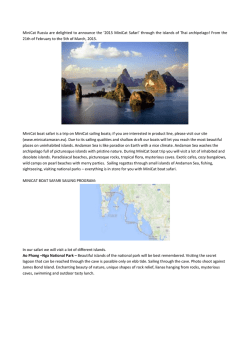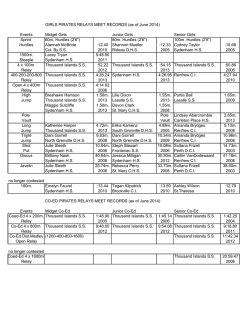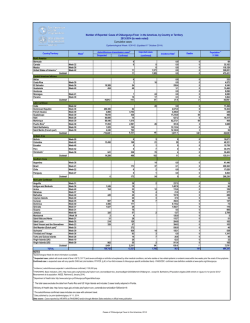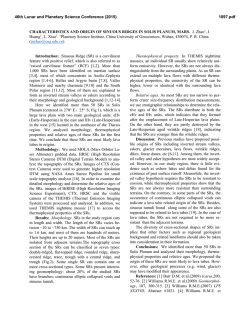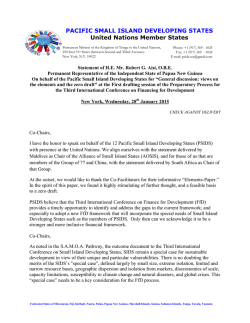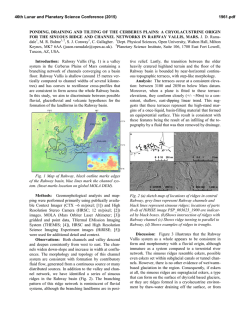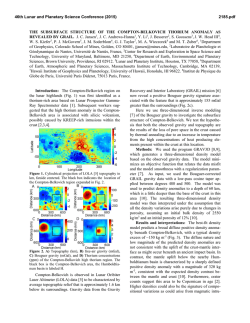
Development of Streamlined Islands During Lava
46th Lunar and Planetary Science Conference (2015) 2182.pdf NO EROSION NEEDED: DEVELOPMENT OF STREAMLINED ISLANDS DURING LAVA CHANNEL CONSTRUCTION. J.E. Bleacher1, C.W. Hamilton2, S.P. Scheidt2, W.B. Garry1, A. de Wet3, P. Whelley1,4, D.A. Williams5. 1 Planetary Geodynamics Laboratory, Code 698, NASA GSFC, Greenbelt, MD 20771 ([email protected]), 2Lunar and Planetary Laboratory, University of Arizona, Tucson, AZ 85721, 3Department of Earth and Environment, Franklin & Marshall College, Lancaster, PA 17603, 4Oak Ridge Associated Universities, Oak Ridge, TN 37831, 5School of Earth and Space Exploration, Arizona State University, Tempe, AZ 85281. Introduction: Sinuous channels are observed on Earth as well as the Moon, Mercury, Venus, Mars, Io, and Titan. Apollo samples showed that fluvial processes did not form channels on the Moon [1], and subsequent planetary exploration has unambiguously demonstrated the volcanic origin of sinuous channels on Venus, Mercury, and Io. However, continued acquisition of new martian data seems to heighten the debate as to whether this planet’s sinuous, and sometimes branching, channels formed via fluvial or volcanic processes. The debate largely arises from the morphological equifinality of these landforms due to some similarities in the mechanisms of fluvial and volcanic channel formation [2]. The issue of channel formation tends to focus on comparisons between the erosive capabilities of lava and water, but a third scenario must also be considered; channel formation via lava construction and drainage. Here we focus on streamlined islands, which can form in channel networks and are often interpreted to be the products of erosion by the overland flows of low viscosity fluids, such as water. However, streamlined islands can also form in lava channels without the requirement of substrate erosion, and so we investigate the December 1974 lava flow on KƯlauea Volcano, Hawai’i, as an analog for the formation of streamlined islands on Mars and other planetary environments. Background and Approach: Basaltic lavas are commonly emplaced as sheet-like flows. In this scenario, basaltic flows inundate the local terrain and may develop internal preferred pathways for molten lava. The pathways can coalesce to form main channel stems within the sheet and are sometimes covered by fragile crust. Initially, these processes tend to be constructional, but if lava in a preferred pathway subsequently drains away, then the resulting landform may develop into a channel-like collapse feature, or lava tube. Here we discuss the development of streamlined islands within sinuous and branching lava channel networks with relevance for interpreting planetary landscapes. We conducted field work in Hawai’i on the December 1974 lava flow of KƯlauea Volcano [3]. This flow erupted from en echelon fissures in the KƯlauea SW rift zone. This ~6 hour event produced numerous overlapping sheets of lava that interacted with the pre-flow topography to produce branching pathways, confluences, and streamlined islands [3–9], some of which define a series of streamlined islands. To assess the subtle topographic influences on flow field development we combined airborne LiDAR [6], ground-based LiDAR [7] and Multi-View Stereo Photogrammetry (MVSP) to produce a 3.5 cm resolution Digital Terrain Model (DTM) for the field site [8]. Results: Our study area is a series of streamlined islands situated at the confluence of two lava pathways (Fig. 1). Here the flow is bound to the S and SE by the Koae Fault System and higher topography to the NW. At this locality, >2 m of relief exists within the sheet, which likely experienced flow thickening due to filling of low topography [9]. The pathways are rougher than the margins of the flow field and have been described as µDµƗ lava. However, our field observations show that the channels are composed of meter-sized slabs of disrupted pƗhoehoe crust. Slabby pƗhoehoe often forms when a crusted pƗhoehoe sheet is disrupted by an increase in flow rate through the sheet’s molten core. Our study concentrates on two of the smaller islands that are 10×20 and 20×30 m in size. The smaller island is flat topped and covered by undisrupted pƗhoehoe lava. The larger island top is partly covered by folded pƗhoehoe that wraps around older, unburied lava, which is tan in color (Fig. 1). The down-flow margins (SW) display a tapered point characterized by flow lines that merge. The island’s topography gradually decreases in height above the surrounding terrain on the tapered end. The E margin of each island also displays a gradual decrease in height to the lower topography. However, the W and N margin of the larger island and S margin of the smaller island are bound by an abrupt contact with the rough, disrupted pathways. The margin is defined by a ~2-m-high vertical wall of lava that represents the core of the sheet. The exposed core also shows tool marks where solidified lava scraped against it while the core was still somewhat viscous. At the top of this wall the texture changes to the glassy pƗhoehoe crust. The crust exhibits cracks where the boundary transitions from a wall of exposed core to the gradually depressed surface forming the tapered tail of the island. The topography across this section of the flow, from NW to SE shows a consistent elevation of 991 m and a smooth pƗhoehoe texture (Fig. 1). The topography gradually decreases by 1 m to the SE and abruptly drops the remaining 0.5 to 1 m to the rough pathway floor. The islands mark a 2 m rise in topography before dropping 1.5–2 m across the eastern pathway. After crossing the eastern pathway the topography becomes smooth pƗhoehoe that embays the pre-flow terrain. 46th Lunar and Planetary Science Conference (2015) Interpretation: The study area within the December 1974 flow was emplaced as a broad sheet-like flow that filled in a local topographic low near the basal scarp of the Koae Fault System. This enabled the flow to attain thicknesses higher than elsewhere across the flow field. Here the flow reached a hydrostatic surface at ~991 m elevation. The surface across which the lava advanced is best described as a hummocky pƗhoehoe tumulus field, which is typical of low slope basaltic terrains. Older tan-colored tumuli adjacent to the December 1974 flow are up to 2–3 m in height and the uncovered portions of this older flow that are also exposed at the top of the larger island, which leads us to interpret that these islands were anchored by highstanding pre-flow tumuli. As these obstacles were inundated by the December 1974 flow, the lava would have preferentially cooled around these obstacles to form a higher viscosity zone beneath a pƗhoehoe crust. Stagnation of these thinner, cooler, and more viscous zones would then have focused the flow into a series of preferred lava pathways located between the stagnant islands that developed within the once continuous liquid sheet. Changes in the local discharge rate through the preferred pathways either due to changes in the discharge rate at the vent or through parts of the lava transport system would then have disrupted the crust of the flow above the pathways. Finally, as the local lava supply waned, partial drainage of the preferred pathways created topographically depressed channels with rough surfaces, bounded by smoother and higherstanding surfaces anchored to the older tumuli. The resulting morphology consists of a relatively smooth flow field with thin margins that is dissected by rough, depressed pathways or channels. This morphology resembles an erosional surface incised into a smooth plain by overland flows of low viscosity fluids, but actually represents an initial constructional process followed by partial drainage within a viscous lava flow. Planetary Relevance: Streamlined islands are often assumed to be the product of erosion by low viscosity fluids and are used as evidence of aqueous flows. However, lava can also create streamlined islands in a manner that appears to involve incision, but is more easily explained by flow thickening due to topographic confinement, followed by partial drainage of preferred lava pathways. This process can be enhanced when sheetlike flows are fed by en echelon fissures and feed multiple pathways weaving their way across the pre-flow terrain [3]. The final dimensions of the channel network and streamlined islands are therefore strongly influenced by both the pre-flow topography and local lava discharge rates, which are affected by vent(s) conditions and modulated by the lava transport system. The December 1974 event was short-lived and low volume erupted. Higher volume eruptions could thicken significantly where obstacles establish large basins to 2182.pdf be filled. For instance, one such channel in the Ascraeus Mons SW rift apron on Mars [10] is bounded by the presence of a large tube-fed ridge. Comparable ridges elsewhere on Mars reach heights of over 100 m of relief. Thus, tube-fed ridges provide geologic geometries where fissure-fed sheet flows could fill depressions to 10s of meters and upon draining, channels and islands with comparable depths and heights. Consequently, we suggest that branching channel networks and streamlined islands within fissure-fed flow fields on Mars could have resulted from a combination of initial flow thickening followed by partial drainage of preferred lava pathways, and therefore do not necessarily imply substrate erosion or modification by fluvial processes. Figure 1. Top left: Airborne image showing the group of streamlined islands. Top right: 3-dimensional image data [8] show a rendered, oblique view of the two islands discussed in this abstract. Bottom: A topographic profile across the study area is shown with both X and Y axes measured in meters. Point A is a contact with a younger flow lobe within the 1974 flow field and Point B is the existing terrain. Acknowledgements: Funding for this work was provided through NASA’s MMAMA, MDAP, PGG and SSERVI programs. Work was conducted within the Hawai‘i Volcanoes National Park under National Park Service science permit #HAVO-2012-SCI-0025. References: [1] Heiken et al. (1991) Lunar Sourcebook. [2] Leverington (2004) JGR, doi:10.1029/ 2004JE002311. [3] Dietterich and Cashman (2014) JGR, doi:10.1002/2014JF003103. [4] Pollard (1983) Tectonophysics, 94, 541–584. [5] Lockwood et al. (1999) USGS Prof. Pap. 1613. [6] Soule and Cashman (2004) BV, doi:10.1007/s00445-003-0291-0. [7] Whelley et al. (2015) LPSC 46, #2140. [8] Scheidt and Hamilton (2015) LPSC 46, #1055 [9] Hamilton et al. (2015) LPSC 46, #1072. [10] Bleacher et al. (2010) LPSC 41, #1612.
© Copyright 2025
